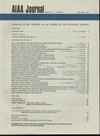T5冲击风洞自由流温度、速度和成分的测量
IF 2.1
3区 工程技术
Q2 ENGINEERING, AEROSPACE
引用次数: 2
摘要
我们报告了在加州理工学院T5反射激波隧道对自由流中旋转和振动温度、速度和一氧化氮(NO)浓度的测量。通过可调谐二极管激光吸收光谱法在50kHz下测量量,同时使用五个激光器对27个量子态特异性跃迁进行采样。为了将芯流测量与周围的剪切流隔离开来,设计了光流切割臂。使用具有不同光路长度的两组臂来评估自由流空间均匀性。本研究共包括九个实验(“快照”),涵盖四个标称条件,储层焓为8-21 MJ/kg,流速为3.5-5.5 km/s。自由流测量通常意味着除低焓条件外,旋转和振动温度的热平衡。我们将温度测量值与五种空气模拟的预测值进行了比较,并在焓较低但NO浓度预测不足的条件下找到了合理的一致性。在较高的焓条件下,我们观察到温度暂时一致,但NO浓度预测过高。测量的速度和模拟的速度在所有条件下通常都很一致。T5流量中还检测到一氧化碳、水和钾,并在相关情况下报告其浓度。本文章由计算机程序翻译,如有差异,请以英文原文为准。
Measurements of T5 Shock Tunnel Freestream Temperature, Velocity, and Composition
We report on measurements of rotational and vibrational temperature, velocity, and concentrations of nitric oxide (NO) in freestream flows at the T5 reflected shock tunnel at California Instistute of Technology. Quantities were measured at 50 kHz by tunable diode laser absorption spectroscopy using five lasers simultaneously to sample 27 quantum state-specific transitions. To isolate core flow measurements from the shear flow surrounding it, optical flow-cutter arms were designed. Two sets of arms with differing optical path lengths were used to assess freestream spatial uniformity. This study consists of nine total experiments (“shots”) spanning four nominal conditions with reservoir enthalpy 8–21 MJ/kg and flow velocity 3.5–5.5 km/s. Freestream measurements generally imply thermal equilibrium of the rotational and vibrational temperatures except at lower-enthalpy conditions. We compare temperature measurements with predictions from five species air simulations and find reasonable agreement at lower-enthalpy conditions but underprediction of NO concentrations. At higher-enthalpy conditions, we observed transitory agreement in temperature but overprediction of NO concentrations. Measured and simulated velocity generally agree well across all conditions. Carbon monoxide, water, and potassium were also detected in the T5 flow, and their concentrations are reported where relevant.
求助全文
通过发布文献求助,成功后即可免费获取论文全文。
去求助
来源期刊

AIAA Journal
工程技术-工程:宇航
CiteScore
5.60
自引率
12.00%
发文量
458
审稿时长
4.6 months
期刊介绍:
This Journal is devoted to the advancement of the science and technology of astronautics and aeronautics through the dissemination of original archival research papers disclosing new theoretical developments and/or experimental results. The topics include aeroacoustics, aerodynamics, combustion, fundamentals of propulsion, fluid mechanics and reacting flows, fundamental aspects of the aerospace environment, hydrodynamics, lasers and associated phenomena, plasmas, research instrumentation and facilities, structural mechanics and materials, optimization, and thermomechanics and thermochemistry. Papers also are sought which review in an intensive manner the results of recent research developments on any of the topics listed above.
 求助内容:
求助内容: 应助结果提醒方式:
应助结果提醒方式:


